When Gregory Wessner introduced Robin Nagle at Open House New York’s ongoing “Getting To Zero” lecture and event series about waste in NYC on May 1st, he said she was the first person to think of when someone mentions garbage. I couldn’t have agreed more, even though my memory had failed me before.
I had been so excited to learn there was an anthropologist in residence at the New York Department of Sanitation (DSNY), a clinical professor for environmental studies at NYU who also was a sanitation worker and wrote a wonderful book about it called “Picking Up”, and Robin Nagle immediately got a place on top of my interview bucket list.
But then all those lists in my head shifted, as they constantly do, and I forgot. Nothing lasts, you might think. But just as garbage doesn’t cease to exist just because it was picked up from the curb in front of your home (as you will be reminded of in the interview that will follow below), memory isn’t erased either.

Robin Nagle
clinical professor of anthropology and environmental studies at NYU,
anthropologist in residence at the DSNY,
born in Auburn, NY,
came to NYC in 1982,
currently lives in the East Village,
would like to watch when future archaeologists will excavate a toilet and wonder about its meaning.
I was sitting unassumingly in the subway when it hit me. The woman who until a few seconds ago had been sitting across from me was someone I would have been thrilled to talk to! I’d noticed she was wearing a green jacket, with a name and something else embroidered on it, in the style of a work uniform. I didn’t see the name, but even at the quick glance that we allow ourselves on the train, I could clearly see “anthropolog”, the rest of it hidden in the shadow of a crease.
I thought of a fashion chain store called Anthropologie, and my mind took me on a trip to a worker uniform fashion show in Paris, where these would be couture and cost a fortune. I realized that was just a fantasy when I glimpsed again while the person wearing that jacket got off the train. This was a real DSNY uniform, and it didn’t spell a brand name, but a title. Robin Nagle had been sitting right in front of me, and then she was gone before I could introduce myself.
But this time, I didn’t let my memory slip away. I made a formal interview request, and by now you can probably imagine how glad I was when she agreed to meet me. I never told her that we had kind of met before. Quite the story teller, I saved it for last, so that this one particular reader learns something new, too. Everyone who is not Robin Nagle: Learn from her about new ways to think about waste, to deal with it yourself, and to look at the sanitation workers in your street – literally, look at them.
To research New York City’s waste, a social scientist might first read, look at data, talk to people. You took it a step further and accompanied sanitation workers. Is this meant to meet the requirements of participatory observation as a method in social anthropology or was it a personal choice?
Robin Nagle: My question was: How do I learn as much as possible? And because I am trained in that particular method and I believe in that method as a way of learning, to me that was an obvious choice. There were two different ways that I did it. One was as you said to accompany, I tagged along. And the other was to take the job and actually be entitled to wear the uniform and do the work myself, and be subject to discipline and have to listen to bosses. This is a way of learning that I was going to try for a particular set of questions.
What did you want to learn?
My question was very simple: What is it like, what does it take to be a sanitation worker in New York City today? And even though I was on the job, I was not on the job for twenty or thirty years. So the limits of my ignorance are still vast.
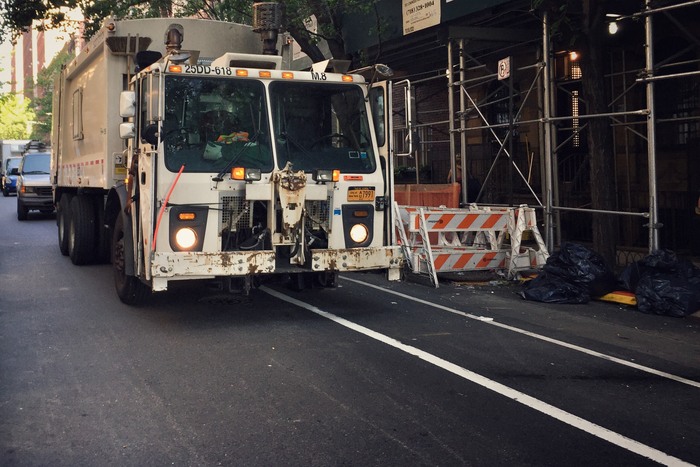
Many sanitation trucks in New York also work as snow plows in the winter – the plow is then attached to its front.
How did you get into that job?
About every four years, the department lets it be known that there is going to be a test for sanitation workers. Every time, between 70,000 and 80,000 people sign up. Then you take the test and it is scored, and if you score strong enough, you are eligible to take the physical exam, which I did. And if you pass this, but don’t have a commercial driver’s license, you are eligible to take the department training. And in between there are lots and lots of other assessments of your strength and well-being. If you pass all of those and then the road test, you are eligible to be offered the job of a sanitation worker.
And you went through all those steps?
That is the only way you can get the job, there is no way that I could go to someone and say: Could you put me in that job for a while, please? That would have been illegal, to start with, but also: How could I look at my coworkers and know what they had done to get that job? It would have been a lie.
That’s a fulltime job. Did you have to pause your academic work for it?
No, I did it both at the same time. Which is one of the reasons why I couldn’t stay on the sanitation job as long as I wanted to. The shift was 6 am to 2 pm, and after my shift I would show up at NYU in my sanitation uniform, and then teach. (laughs) I’m sure it was a little confusing for some of my students.
Did it affect the interest of your students in any way?
I’ve always drawn students who are interested in the subject of garbage, waste and urban infrastructure, so I’m not sure that just wearing a uniform made a difference. And I changed once I got here.
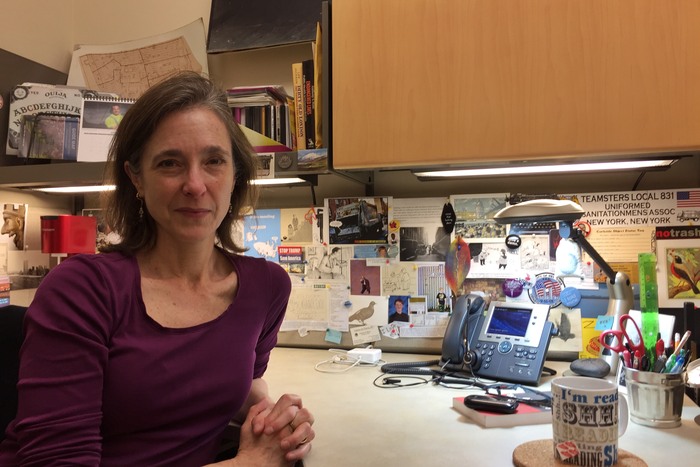
Robin Nagle in her office at NYU.
So among other things, you teach about garbage. What is garbology?
I don’t know, because it is not my word and I don’t tend to use it. Some colleagues and I have begun to use something called “discard studies”. It includes garbage, but it is also a broader idea about practices of waste: What is the social place of waste as a category but also as a behavior, as an economic component of manufacturing?
Is “discard studies” an academic term?
Well, it is meant to be more encompassing that just academia. It also includes professionals in the field, activists, artists, journalists, and anyone who’s working with any problem that involves any form of waste. How can we combine our knowledge and experiences and theories and ways of considering whatever is the issue, as long as it’s related to discards, and then share that with each other? This dynamic is too big to be contained within just academics.
What is the goal?
The goal is to make more public, prominent and obvious the really fundamental problems that waste poses, and to think about solving them in a more holistic way by drawing on all these different forms of expertise and wisdom. Garbage is implicated in every environmental crisis we face today. We as individuals and as cities didn’t create the commodities that become discards pretty quickly, from plastic water bottles and disposable coffee cups all the way up to appliances and cars. We didn’t manufacture them, but somehow we are responsible for what happens to them when we’re finished with them. That’s backwards!
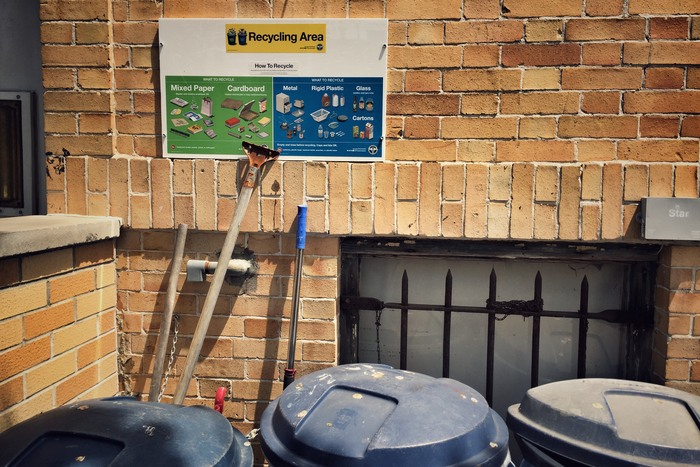
Waste bins in front of an NYC apartment building, accompanied by information for residents about how and what to recycle.
And what would be forwards?
One of my goals is to have and encourage a conversation that looks upstream. There is a writer and activist named Annie Leonard who has a wonderful metaphor for this: Imagine that you’re leaving your home, and the kitchen sink is running and clogged, so when you get home, you find a flooded kitchen. If you only worry about mopping up the flood, but you don’t turn off the faucet, you won’t solve the problem. So my goal in discard studies is to help broaden, deepen and enlarge perspective about that particular issue of waste. We need what’s called a circular economy, where material isn’t going in only one direction, but it’s going around, through reuse, recycling, or smaller levels of consumption.
That sounds a little bit like you’re suggesting that producers of packaging are held more responsible …
And that doesn’t just go with packaging, it’s producers of everything. So that when I am a car manufacturer, I sell the car, and then at the end of the car’s useful life, I have an obligation to take it back and to use and recycle whatever components I can. The car example is an easy one. In fact, in Europe, there are laws about extended producer responsibility; they are far more rigorous and far-reaching than they are here.
Yeah, I know.
You know it better.
I don’t know about that, but my experience from Germany raises another question: What can you tell about our differences in awareness of waste and environmental issues?
Part of the problem – and I don’t know how the Germans teach a different relationship to these concerns, so I can’t actually compare – there is still a pretty fundamental disconnect between a person on the street and his or her sense of the way our daily practices and choices have an impact on larger concerns. This puzzles me a lot. Let’s say everyone in one workplace believes strongly in environmental activism, believes in climate change, feels that the levels of responsibility extend from the individual up to the highest levels of government and industry – but they use these little coffee capsules. And every time they have a cup of coffee, they generate this plastic waste. Every time! To me that’s a disconnect. If you want to commit to environmental sustainability, resilience, activism, the plastic coffee capsule is a contradiction. But I see it a lot. Is that about convenience, is that about “Oh, my little coffee thimble isn’t gonna make a difference”? Well, yes it does. And it is modelling behavior. If we didn’t use them, they wouldn’t sell. And if they didn’t sell, they wouldn’t be made. So your choice can ripple back up.
There’s also a stereotype of New Yorkers feeding on take-out. Does your own experience as a sanitation worker support that, just anecdotally?
Well, I didn’t look in the bags very much, so I can’t answer that. I was just throwing them in the back of the truck.
And when you release it at the waste site, you can’t see what was in there?
The technical term for what is pushed out of the truck is “turd”. You’re not really scrutinizing the turd. You do see it, but it’s all still in the bags.
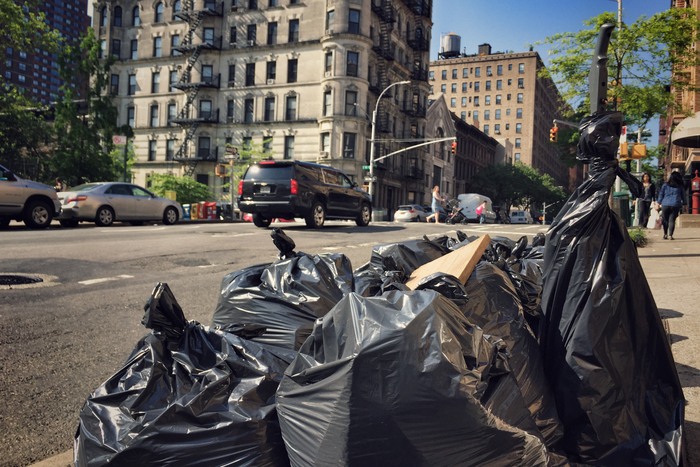
Black bags are used for household waste in NYC. Garbage from private homes and apartments accounts for about a third of the daily ~35,000 tons of waste in NYC. The other two parts come from commercial waste and construction, which are both picked up by private carter businesses.
The bags don’t break?
It’s all very compressed, but it’s not like all the bags explode and you have a mash of stuff. Some do, but mostly you still have bags. And in regards to take-out: If someone is conscientious and the container can be recycled, it shouldn’t be in the trash anyway.
Did you never work the recycling routes?
I did. But I really wasn’t scrutinizing the contents. I was just trying to make sure that I backed up the truck correctly on the scale, which to me felt like the scale was only this big (shows), but the truck was this big, and the room I had for the truck was this, oh, it was a nightmare. And I did it wrong, more than once, and then they had to reset the scale, which takes time, and they would yell at me. So I was not worried about “Is that take-out stuff in there?”, I was worried about: Don’t yell at me again! I don’t like backing up!
That’s the stereotype for women driving, right? Backing up?
Is it really? Oh no, that’s even worse.
I think it’s “women can’t park”, so it’s getting close. Sorry, I didn’t mean to ruin your day.
Glad to know I lived up to the stereotype.
So nobody ever mentioned that at work?
No, no, and, no. I think people were just being polite. And also: If it’s understood that you are harassing someone because she is female, you can get in trouble for that. I think they were being careful. Also, frankly: I wasn’t the only person that had trouble. The other new hires, the men, they couldn’t do that either.
Ha! Good! So we can dump the stereotype! Was there any particular experience on the job that sparked a new interest for your research?
I’m not sure if it sparked a new interest, but it confirmed my hunches. I had known that the work was invisible, but the actual invisibility that I found wearing the uniform was impressive. I was in a mechanical broom or in a truck on the streets, and it’s a big, loud machine, but the general public’s attitude was to look past that. And then the physicality of it: Again, I knew as a statistic that on some garages you will be lifting 20 tons a day. But to actually do it! I was not in that particular garage, but I had my share. My heaviest day was 14.85 tons.
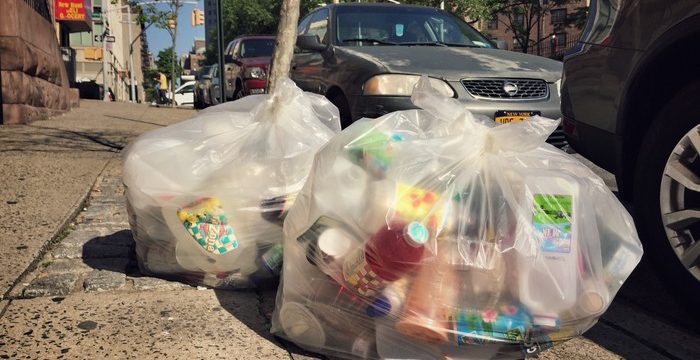
Household recycling goes into clear plastic bags before curb pickup.
Wow!
Even though I was in pretty good shape at the time, you feel it in your hips, bones, back, leg muscles, and shoulder muscles. People had told me that it took years for them to adjust so that they didn’t go home every day hurting. Even when they were very careful to lift with their legs and not their back and make sure their partner helped them with the heavier bags. But to actually wear that on your body, that was a deep lesson. And people think it’s an unskilled job, but that’s not true at all.
So what does it take to be a sanitation worker?
There is a range of knowledge, not just information, but knowledge that you have to master to do the job well. You can try to just follow the orders for the day, work these blocks in this order. But when you get there and you see some obstacle or problem, how do you recalibrate in a way that you still get the work done? And the trucks are complex machines, which have many surprisingly delicate parts. What do you do when one of those breaks? Also, you need to learn how to work with the public who are in your district to help them do their part better so that your job is a little bit safer. Sanitation worker is one of the ten most dangerous jobs in the country. And I found out why: The risk from traffic is dramatic and constant. And then what we put in the trash becomes a source of harm, partly because of the way that we discard it, and also because of the way you put it in the truck: With the pressure of the blade it can come flying back out.
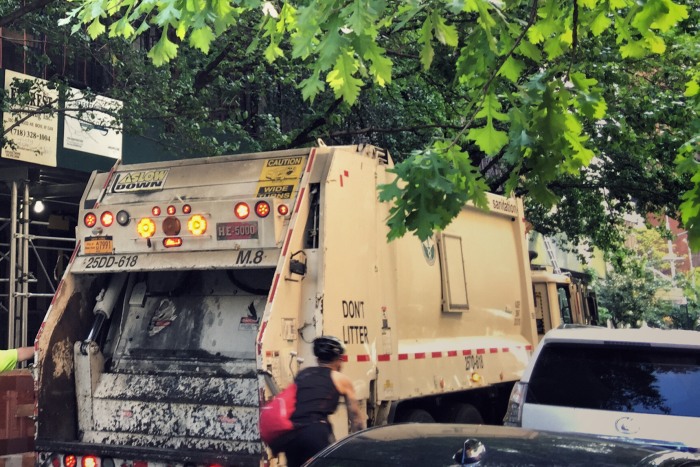
Sanitation truck on a Manhattan street where sanitation workers pick up curbside garbage.
The invisibility you experienced touches on something you wrote in your book, “Picking Up”: “If we ignore the dump, we can more easily ignore the simple and chilling fact that nothing lasts.” Do you think that is a universal behavior or are there any cultures who deal with trash completely differently than we do?
In the world today, on a broad scale: not that I know of. In the past, cultures have had a range of different attitudes towards history and legacy and death and what lasts. In fact, there is a field that looks at different ways of dealing with death in different cultures across time. That is a very big question that I am not entirely sure how to answer.
What has waste taught you about evanescence?
Let’s say we evacuate the earth right now: Hundreds of years from now, plastics will still be here. We don’t even know their half-life, literally. Plastics mean that we are going to leave a legacy. And it could be the mark of the Anthropocene as a geological layer. There is a new form of rock called Plastiglomerate – which is plastics that have melded with minerals – that now washes up on shores in Hawaii, for instance. That will endure far, far past our own existence. So we are creating this ghastly legacy (laughs), even as we are imagining that we are custodians, of not just disposables but everything around us. But in fact, we are what’s temporary. And that’s what’s going to last. All that stuff.
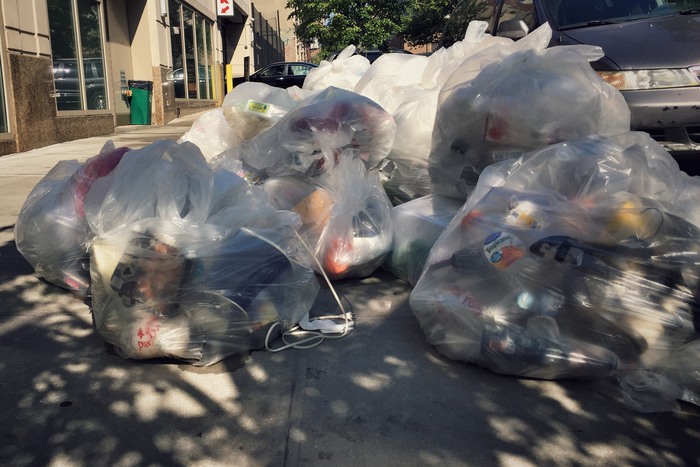
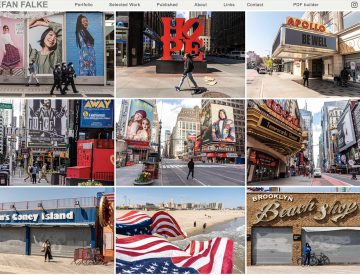
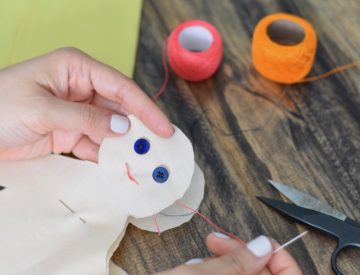


Comments are off this post